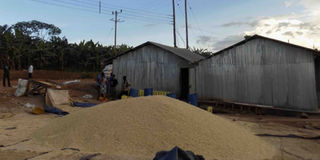Hawking oneself into owning a milling factory

Kakinga Maize Millers factory in Ibanda District. If a kilogramme of maize flour costs an average of Shs1, 000, it means a miller can earn Shs200, 000 if they sell a minimum of 200 kilogrammes a day. File photo
What you need to know:
Great minds know when an opportunity knocks at their door. They seize it fast. This was the case with Edison Lucky who started milling maize flour from scratch. Joseph Kato shares how a maize vendor built his maize milling factory.
“Work like a slave live like a king,” is an old proverb that befits Mr Edison Lucky, a maize hawker who turned into a factory owner in Ishongoro Town Council, Ibanda District.
To appreciate Mr Lucky’s achievements, you need to comprehend his journey to success. While in primary school, Lucky could vend boiled maize from which he could raise his school fees. He sold each boiled maize cob between Shs100 and Shs300 depending on the size. On a good day he could earn between Shs5,000 and Shs10,000.
That time, his main challenges were waking up very early in the morning to prepare the maize, and also people who could sometimes eat his maize without paying.
“I was growing maize on an acre of land. When I joined secondary school, I decided to grow maize on three acres purposely to increase output and sales. I changed from selling boiled to dried maize to millers,” Mr Lucky recounts.
Mr Lucky sold dried maize for two years and realised he was getting peanut from his energies as a kilogramme could be bought at Shs100. The only solution was to add value to his products. At this time he was producing more than a hundred 50kg sacks of dried maize every season. It was then that he decided to venture into milling maize into flour to sell to nearby schools and individuals.
“At that time I had no money to buy a grinding machine. I approached one miller and convinced him to allow me mill from his factory. He could charge about Shs1,000 per 50kg sack,” he says.
How the milling started
The 30-year old man started a maize flour shop which, he says, improved his earning fast. He realised that selling dried maize was making him lose about Shs15,000 per 50kg sack.
Mr Lucky started buying dry maize from other farmers to increase his output. This increased his market.
Schools started to contact him to supply them with maize flour and he therefore needed a huge stock not to disappoint his customers.
Opportunity knocks
Luck came Mr Lucky’s way. In no time he had raised enough money to buy the factory at which he used to mill at a cost. He say he made Shs20m as down payment and cleared the balance in two months’ time. This was when Kakinga Maize Millers was born.
“I was lucky when the owner of the factory was shifting and selling his factory at a fair price. I had collected almost Shs40m from profits and I used part of it to buy the factory,” he shares.
Today, Mr Lucky produces a hundred 50kg bags of maize flour every day which he sells to retail and wholesale traders in neighbouring towns. He says packing his products in different sizes has helped him get many customers of all income brackets and this has increased his earning over the years. In the last five years, Mr Lucky’s profits have grown to about Shs2m per month after all expenses are paid.
What others speak of him
Ms Alice Kahanga, a maize and beans grower, is all praises for Mr Lucky because of the pre and post-harvest handling skills he passes to them.
“My output was always very low and of poor quality. Mr Lucky brought for us trainers who trained us on good agricultural practices ranging from garden preparation, fertilizer usage and weeding using chemicals,” she notes, adding that Mr Lucky helps them get tarpaulins on which they dry their maize and beans, something that has boosted quality.
Sensitisation of farmers
“I used to get maize of poor quality from farmers that could come mixed with soil, animal droppings and other unhealthy stuff. I decided to teach them good agricultural practices,” Mr Lucky says.
The maize miller partnered with USAID Feed The Future which trained 10 of his farmers who became village agents and have passed good agronomic practices to other farmers.
Lucky’s challenges
His major challenge is lack of a drier and some customers who take maize flour on credit but take long to pay him, which stagnates his work.




